Though they’ve been part of the electric guitar
scene for nearly half a century,
stompbox builders have always had
something of a reputation for being odd outsiders,
maybe even a little romantic—in that
garage-entrepreneur kind of way. Luthiers? It’s
easy to imagine them as crabby old cobblers
and cabinetmakers, clad in overalls, bifocals,
and tweed. But pedal makers—they’re a cross
between some Manhattan Project dropout and
a greaser chopping a ’49 Mercury on the front
lawn. A little bit weird, an affront to the status
quo, and most certainly up to no good.
Like any legend, it’s partly true (just have
a look at some of the oddities among the
30 pedal reviews elsewhere in this issue).
But for all its fringe tendencies, the world
of independent and boutique stompbox
builders is fast transforming into a brave
new world of refined craft, high technology,
creatively applied engineering, and
soundscapes yet unexplored. And, ultimately,
the transformation is a boon to
us, the players. Because whether a pedal
is designed to capture the unholy fuzz of
some all-germanium obscurity made for
three days in 1967 or help us make wholly
original sounds, boutique builders are
helping guitarists be more expressive and
creative than ever.
The five stompbox builders profiled here
are among the most inventive and respected
in the trade. They are certainly not the
only innovators in the pedal industry, but
they represent a cross section of the traditionalists
and the tweakers who continue
to make our artistic and tonal pursuits
an adventure.
Strymon
Red Witch
Mad Professor
Crowther Audio
Empress Effects
e
Strymon
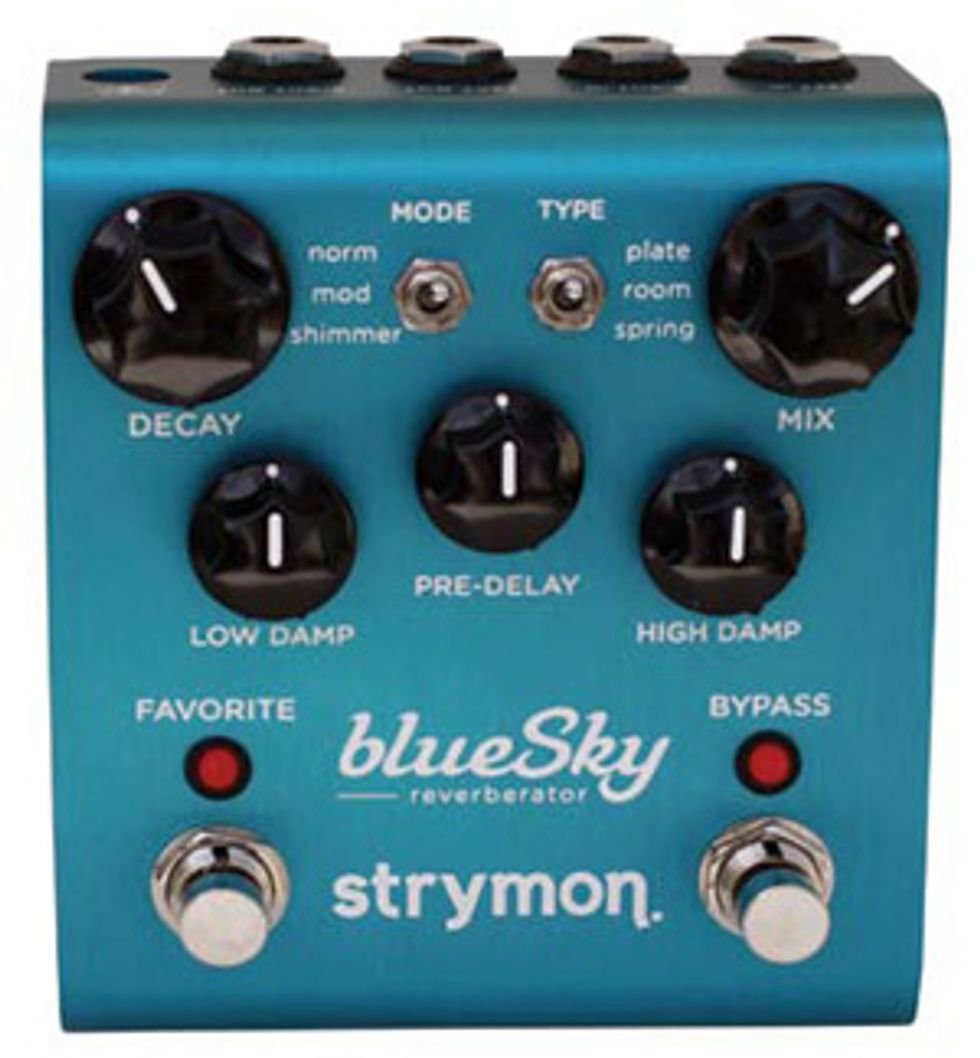 |
Strymon effects is the brainchild of founder
Terry Burton, but the Westlake Village,
California, company runs on the collective
power of an engineering brain trust—a
gang of self-declared “left-brain artists”—
that, in some ways, represents a shift
toward acceptance of digital in the boutique
marketplace. Because, unlike many
boutique pedal houses, Strymon enthusiastically
embraces digital signal processing
(DSP) technology. While scorned by some
analog purists, DSP enables Strymon to
create some of the most authentic vintage
sounds available to guitarists.
Strymon’s DSP pedals—the Blue Sky
Reverberator, the Orbit Flanger, the Ola
Chorus & Vibrato, and the Brigadier Delay
(all reviewed in the July 2010 issue of PG)—
have drawn raves for their approximations
of analog sounds. And the company’s latest
pedal, the El Capistan (see the review on p.
182), may be the most refined realization of
Strymon’s aspirations—a processing powerhouse
in a pedal that can simulate the fuzzy
warmth, irregularities, and imperfections of
tape delay and transport the user to truly
bizarre sonic realms that only complex digital
processing makes possible.
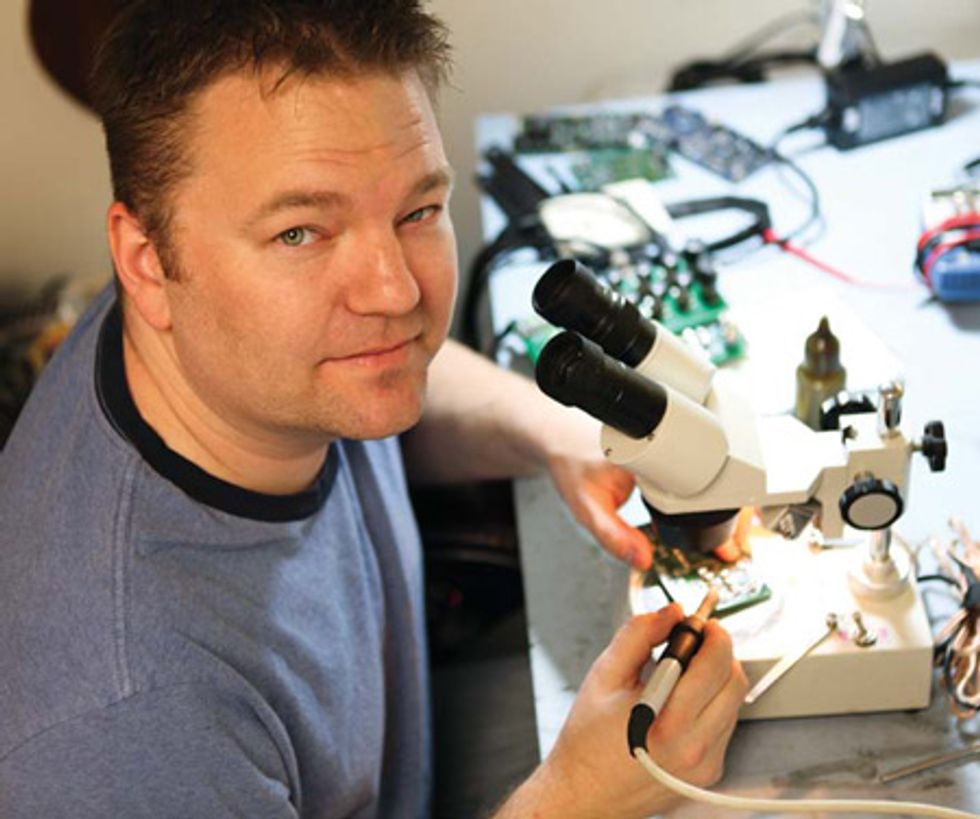
Strymon’s Dave Fruehling holds the title of
Firmware Architect Genius.
Strymon’s analog engineer, Gregg Stock, explores old-school ways with a
heavily modified, Floyd Rose-equipped Gibson Explorer.
Strymon founder Terry Burton with an SG and a Brigadier delay (foreground).
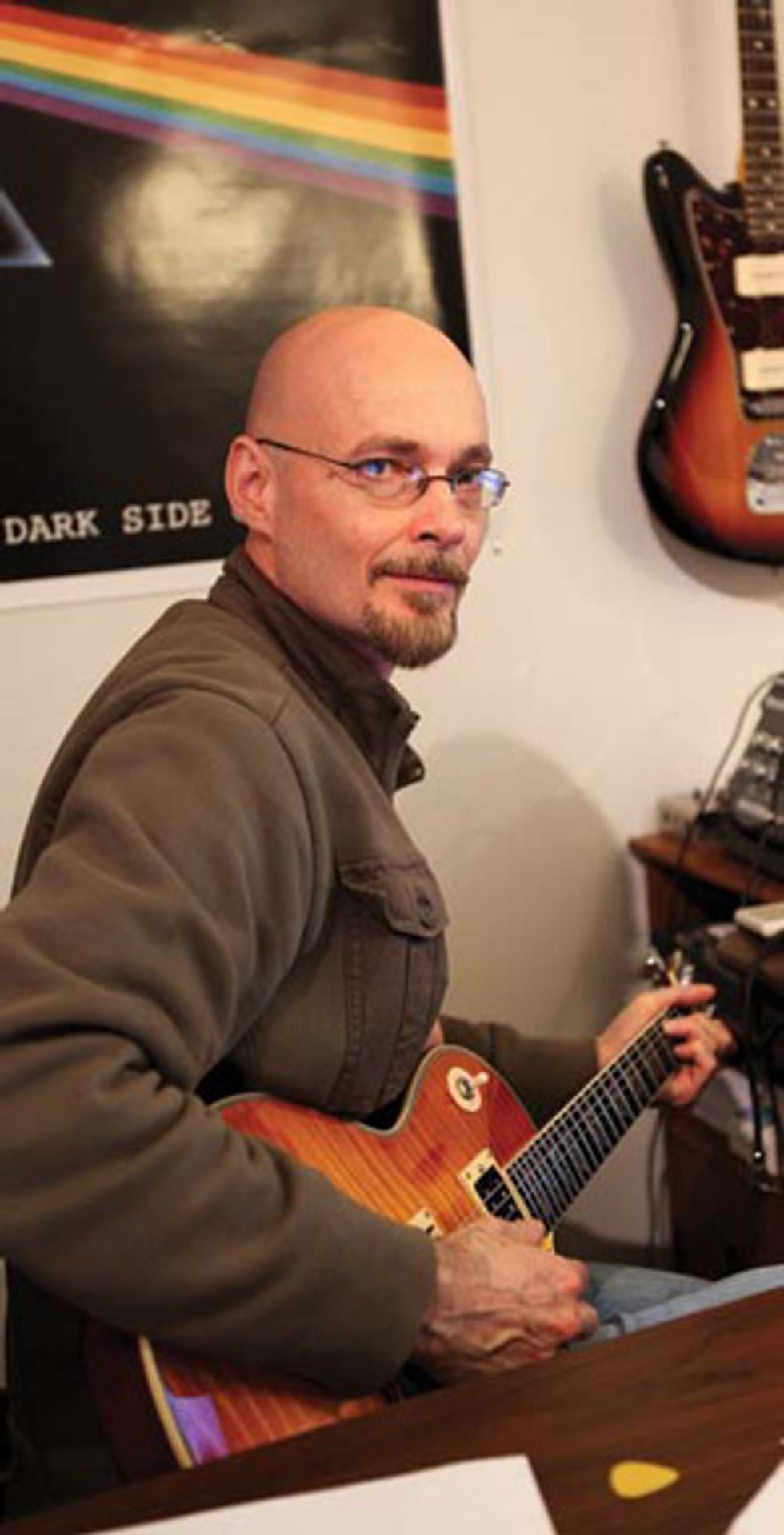 |
Burton was just a teenager when he caught
the pedal bug. And like most builders, he
was blown away by the sound of the analog
classics—in his case, a Thomas Organ-built
Crybaby wah and an A/DA flanger that
would ultimately inspire the Strymon Orbit.
“My uncle let me borrow his A/DA
Flanger, Crybaby, and a Yamaha SPX90,
and I abused the privilege by taking
everything apart and reassembling it at
least 20 times in an attempt to find out
how things worked,” explains Burton. “I’m
currently still ‘borrowing’ the A/DA and
the Crybaby after many years.”
Burton’s abuse of the Yamaha SPX90 may
have opened his mind to the potential
of digital circuits as he was falling in
love with analog sounds, but he was also
inspired by some distinctly contemporary
sounds overlooked by many pedal
hounds: Andy Summers’ modulation and
delay on Police records, the modulation
sounds achieved by the Pretenders and
the Cure, and the aggressive guitar-straight-
into-amp tones of Fugazi. That
wide perspective on musical history—and
the open-mindedness about what defines
a great tone or great record—is a big
part of the Strymon design mindset.
“Obviously, delay, reverb and modulation
all existed before we started making our
own. Sometimes we try to take existing
effects into uncharted territory and sometimes
we are trying to solve a specific
set of problems that existed in analog circuits,”
says Burton.
“When we developed the Brigadier Delay,
we knew that the nicer, high-voltage analog
bucket-brigade chips were nearly impossible
to get and that all analog delays
suffered from certain problems like poor
signal-to-noise ratios, distortion, and limited
headroom. Of course, these ‘problems’ are
part of what make analog delays cool,”
Burton admits. “So we implemented discrete
bucket brigade stages in DSP and
added a control for ‘bucket loss.’ That
single control lets you have a cleaner analog
delay than has ever existed before or a
very dirty and noisy one. With El Capistan,
the goal was to capture all of the electrical
and mechanical nuances that make classic
tape delays sound the way they do—and
put that technology in a small form factor
without the maintenance nightmares that
plague traditional tape delays.”
Burton and his team understand why players
treasure analog sounds. But unlike many
players who have chosen sides along the
digital-analog divide, Burton sees digital
as a way to look backward and forward
simultaneously. “I think the analog fixation
that many players have is not unfounded,”
Burton says. “And there certainly have
been many digital products released over
the years that have failed to deliver the
goods. We are keenly aware of this when
undertaking our DSP designs. But if we’re
successful in achieving our design goals,
the technology becomes irrelevant. What
we know and love is making hardware, and
we want our hardware to be not only great
sounding, but also fun and satisfying to use.
Traditionalist or not, if someone sits down
in front of a pedal and that pedal inspires
them musically, then it’s a successful design.
My hope is that we’re always using the
authentic sounds as a foundation and building
from there. In addition to making things
that conjure the days of old, we also want
to create sounds that haven’t even existed
before. And, we’ve got lots of projects
cooking in our labs.”
Red Witch
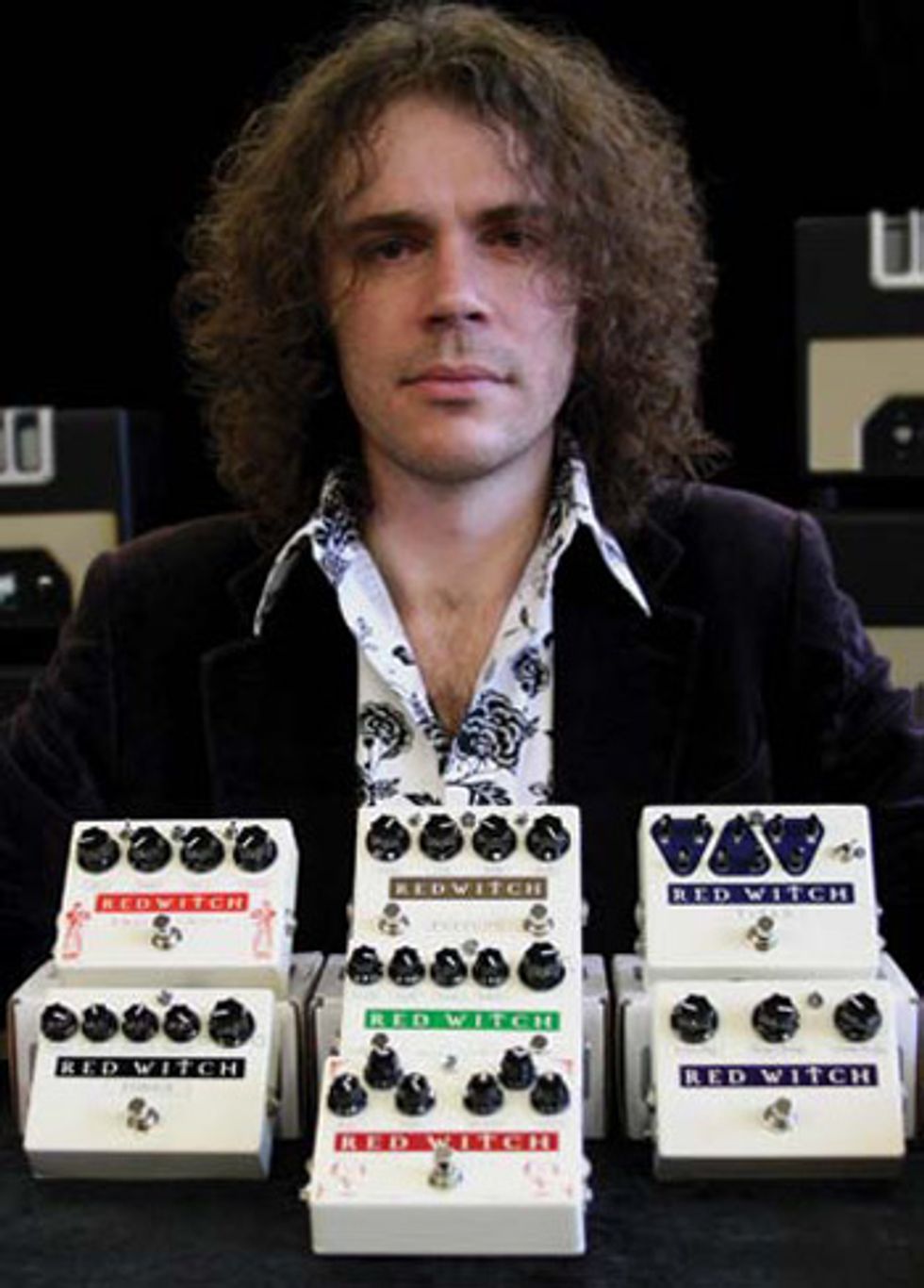 |
The seeds for New Zealand’s Red Witch
pedals were sown when founder Ben
Fulton’s girlfriend bought him a Holden
50-watt amp head in need of work. The
repairs, as well as the need for some effects
to put in front of the amp when it was
healthy again, prompted a fascination with
preamp, amp-modulation, and pitch-modulation
circuits that led to his first effect—the
Moon Phaser. The project was originally
intended for Fulton’s personal use, but his
friends dug the little pedal and the requests
started coming in so fast that a business
was born.
Today, Red Witch’s line includes the Deluxe
Moon Phaser, the Pentavocal Trem, the
Empress Chorus, the Fuzz God II, the
Famulus Distortion, and the Titan Delay.
The motivation behind each of these pedals
is the same that guided the design of
the first Moon Phaser: “The boutique pedal
scene was much smaller eight or nine years
ago, and there were a lot of guys building
clones of classic, out-of-production pedals,”
says Fulton, recalling the early days
of Red Witch. “There were a lot less folks
doing new or innovative stuff. I’ve never
had any interest in copying or cloning other
people’s designs. Manufacturing anything—
your own idea or someone else’s—is a
huge amount of work. So I figured from the
outset that I’d prefer to put my time and
energy into something that was unique, different,
and, most importantly, my own.”
Though he was eager to carve out his own
niche, Fulton knew what sounds he liked on
record. Not surprisingly, Fulton’s list of sonic
influences was broad and varied, ranging
from experimental Japanese guitar expressionist
Keiji Haino to pioneers like Jimmy
Page and Mick Ronson—players that, as
Fulton put it, had “a purity of expression.”
“Page’s palate has had an influence,”
Fulton says. “The range of tones that he
got with guitar, amp, and pedal combinations
in the studio is staggering—layer
upon layer of guitar parts, each with a
slightly different treatment. Beautiful.”
Another Brit was also a huge influence on
Fulton’s sonic philosophy. “I loved Alvin
Lee’s guitar sound, that blistering playing
in the late ’60s—very clear and articulate.
I guess with our Fuzz God II and Famulus
distortion, I really strived to get that clear,
punchy sound happening. No additional
frequencies, nothing that would allow the
guitar to get muddy in the mix.”
Fulton’s interest in not just the specific
pedal tones but the overall playing
approach of the greats keeps him from
obsessing over emulation, which means
he can focus on the flavors that make
his pedals different. It also means he can
refine them to the point of being practical
rather than a gimmick. “I’ve designed
every device to offer guitar players
really useable flavors in the specific effect
genre—and then something totally new
that’s not available elsewhere, but that’s
also totally useable.
“There’s no point offering bells and whistles
that you’d never use,” he continues.
“For instance, our Moon Phaser offers
three different styles of phasing, as well
as a gentle tremolo setting. In addition,
it offers our unique Tremophase—where
the phase shift occurs at the same time as
the tremolo’s volume pulse. No one else
has done that before, and the Red Witch
Moon Phaser remains the only source of
this new, useable sound.”
For all his concerns with practicality, Fulton
also doesn’t mind tinkering with radical
sounds. Though even his pursuit of more
“out” sounds are in the name of musical
ends. “I’ve always loved contrast within a
piece of music,” he says, describing one
of his musical guidelines for design. “You
want to make a section of song seem really
loud? Play really quietly before it. And
vice versa. The Fuzz God can do really
subtle fuzz sounds—but then you can click
one footswitch and enter a world of sonic
insanity. It allows you to shift between two
extremes very easily.”
In the end, Fulton’s concern with musicality
reinforces his own primary directive—staying
creative as a pedal maker so that musicians
can be creative with his creations.
“I think our customers are the players out
there who really pay attention to their whole
approach—playing, tone, and gear,” Fulton
says. “They want the classic sounds but they
also want to push the boundaries. They
don’t just want to emulate their heroes, they
want to develop their own voice.
I try to design stuff to help folks do that. I’ve
never considered whether people use them
to the full extent of the box’s capabilities. As
long as the pedals are helping to open new
creative avenues for them, I’m happy. I think
that’s part of the appeal of our stuff: you can
use as few or as many of the features as you
like. Either way, offering something unique
opens new avenues of expression for them.
I like that idea a lot!”
Mad Professor
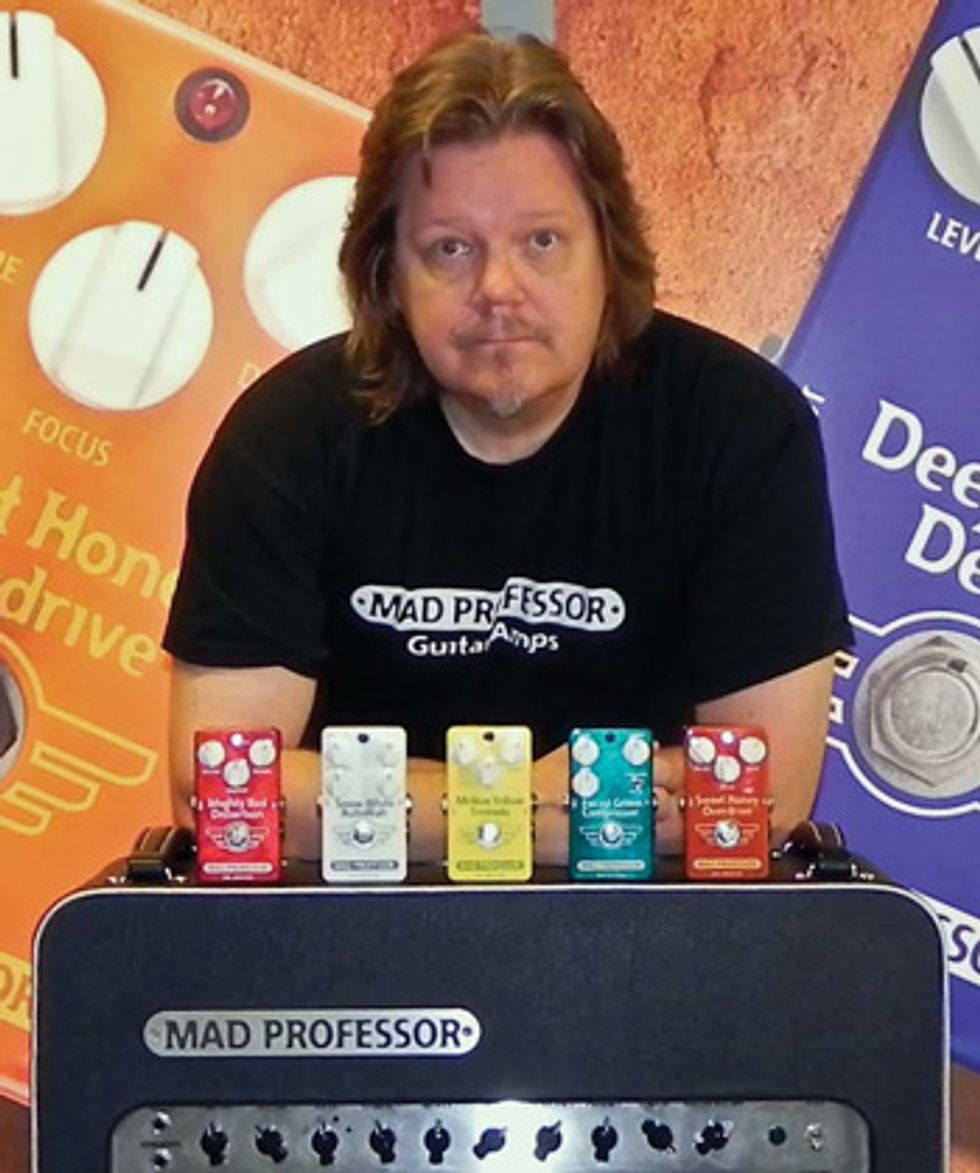 |
Finland’s Mad Professor company is just eight
years old, but in that time the company has
built one of the most extensive lines of pedals
offered by any small-scale, independent
stompbox maker. The company is effectively
a partnership between founder Harri Koski,
amplifier specialist Jukka Monkkonen, and
electronics genius Bjorn Juhl, who designs
the company’s pedals.
Koski started Mad Professor after his experience
operating Custom-Sounds, a company
he founded in 1996 to distribute highend
guitar gear in Finland. Custom-Sounds
was also one of the first online boutique
dealers in Europe, and had a web shop up
and running by 1996. But for all his love of
boutique and vintage gear, Koski was still
frustrated with the limitations of much of
the gear he was hearing. Meeting fellow
tone obsessive Juhl led to creating the Mad
Professor CS-40, the amplifier that put the
Mad Professor brand on many guitarists’
radar. Since then, Mad Professor has built
a roster of 12 stompboxes that includes
three flavors of overdrive, a phaser, a fuzz,
an analog delay, a tremolo, and even auto
wahs for guitar and bass.
Juhl still masterminds most of the pedal
designs. He’s self-taught in the ways of
effects building but has worked with musical
instruments since the age of 16 and studied
electronics for 30 years—ultimately drifting
away from his electronic service shop and
into design of his own effects pedals and
products for Mad Professor.
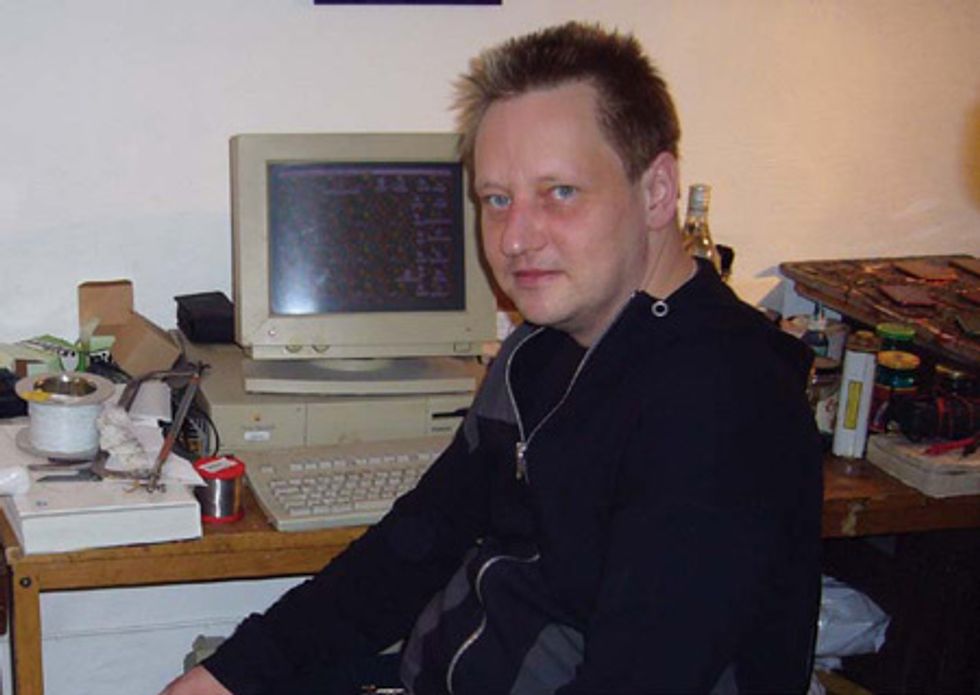
Bjorn Juhl is an electronics autodidact and the principal designer behind Mad Professor’s pedal line.
“If I could have gotten the sounds I wanted
to get at the time, I wouldn’t have bothered
trying to build stompboxes,” says
Juhl, recalling his earliest investigations of
effects. “Back in the late ’70s, I could look
at Electro-Harmonix, MXR, and Boss pedals,
which are all still very good today. And
I also read the excellent book Electronic
Projects for Musicians by Craig Anderton.
But I learned by process of elimination, too.
I built little models of amplifiers to investigate
exactly why certain things sounded
bad and removed everything that sounded
bad until just the good stuff remained.”
Like many of the builders profiled here, Juhl
rejects the notion that the best pedals have
been made—that the stompbox frontier
was conquered decades ago. Tones that
inspired him include Pete Townshend’s Live
at Leeds sounds, Billy Gibbons’ vast palate,
and the aggressive, monster grind of the
Sex Pistols. But he’s always on the lookout
for the ways in which existing pedals come
up short, and listening for sounds he can
imagine but doesn’t hear in the collective
soundscape. “I’d actually say that the
biggest inspirations for me are the most
uninspiring sounds,” Juhl says. “I’m always
trying to figure out why certain combinations
of guitar and amplifier work, why
some really don’t work, and some work just
fine. Because you can change those things
when you’re in the know.”
So far, Juhl, Koski, and the rest of the Mad
Professor team have been successful in
uncovering the little differences that pique
the interest of a sizable number of tonehounds.
Pete Anderson, Jerry Donahue,
Marc Ford, and Jim McCarty are just a
few of the players who have stocked their
quiver with Mad Professor pedals. And
the company remains committed to adding
new tools to their line, including a
forthcoming EQ pedal that found Juhl considering,
among other things, the impressive
bandwidth of Shadows guitarist Hank
Marvin’s tape echoes.
But just as Juhl and Mad Professor look
for inspiration in odd places, they look to
make their products inspirational so that
players will unlock their imagination when
they plug in a Mad Professor box. And
Juhl hopes that commitment will help players
push themselves instead of relying on
gear to solve problems. “Back in the ’70s,
stores had one fuzz pedal and they’d tell
you ‘Take this, son—this is just what you
need.’ Then you’d go home and read Tom
Wheeler’s book where he says there may
be a little more between you and Jimmy
Page than a fuzztone pedal.”
Crowther Audio
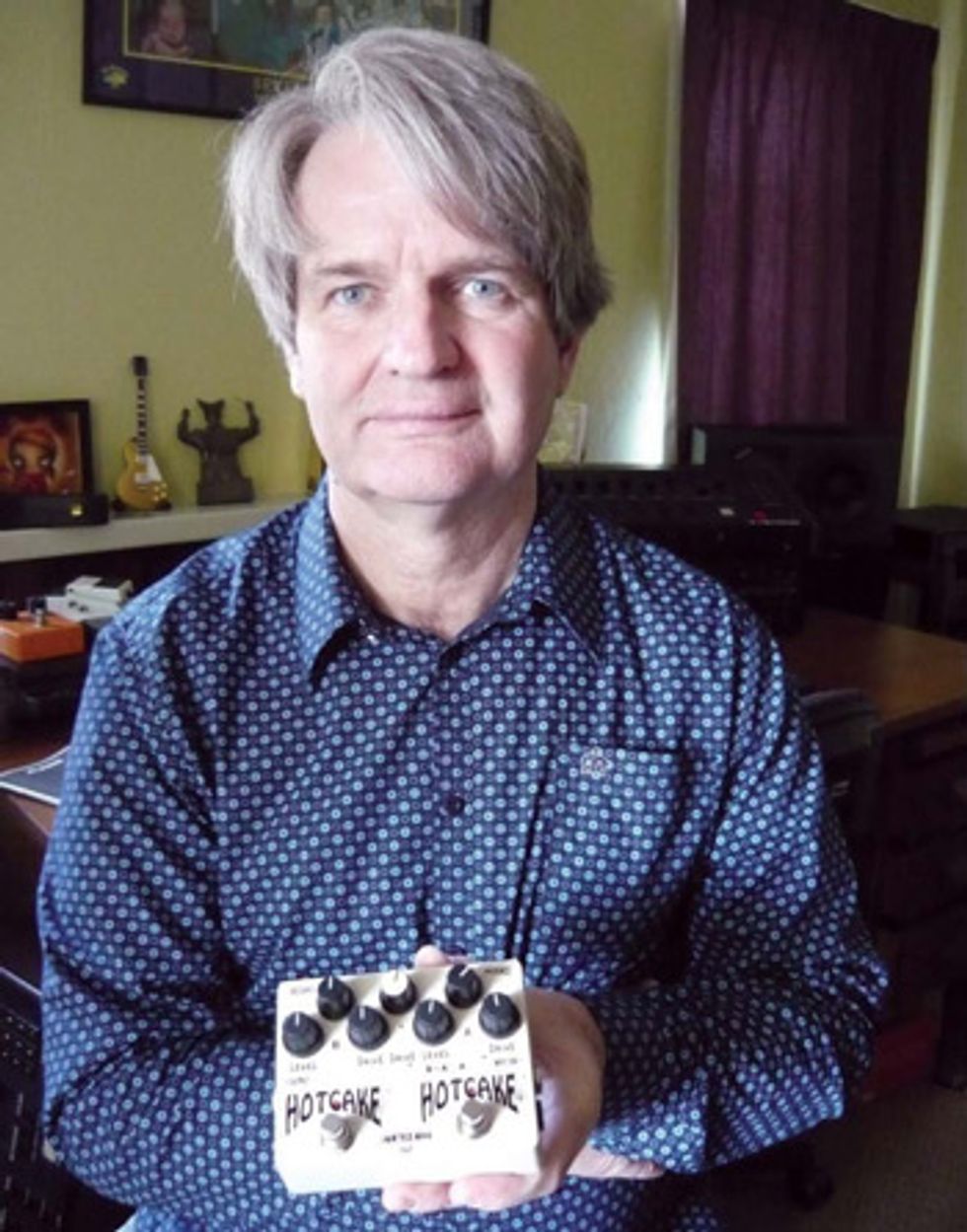 |
In the relatively young business of boutique
pedals, Paul Crowther could be fairly
regarded as a grizzled veteran. He built
the first version of his signature pedal,
the Hot Cake, in 1976 while laying drum
tracks with legendary New Zealand prog/punk/new wave unit Split Enz. Perhaps
it was the unique perspective of watching
guitarists struggle with tone from the
drum riser that ultimately drove Crowther
to build the now legendary and revered
Hot Cake. But his investigations were
founded on a fascination with the circuitry
of sound that predated his days as a professional
musician.
“After hearing the Rolling Stones’
‘Satisfaction’ on the radio, I just had to
make a fuzz box,” Crowther recalls. “I
built the first one from a magazine project,
using four germanium transistors. It
had a volume control but no gain control.
That was the first time I ever made a circuit
with solid-state parts. It had quite a
long sustain, but cut off abruptly, because
it used a ‘Schmitt trigger’ circuit—definitely
a one-note-at-a-time unit!”
But even then, Crowther was looking for
ways to address musical needs beyond
what a fuzz or wah could do. “I was playing
drums in a covers band, and we were
learning the Hollies’ ‘On a Carousel.’ I
made a box to give a guitar that resonant,
banjo-like sound in the intro. It had a
six-position switch for different resonant
frequencies, and it used a big radio-choke
inductor. It also had a control for adding
the low frequencies back in. It distorted
just a little bit, too, and our lead guitarist
used it for all sorts of things. I called it a
Herbert Box for some obscure reason.”
When Crowther finally got around to
building the Hot Cake, he’d worked on
tone circuits for everything from wah pedals
to organs. But Crowther ultimately
relied on his ears to perceive the needs
that the Hot Cake addressed—essentially
how to make a guitar signal hotter
and more distorted without sacrificing
the best and most essential parts of the
guitar-amplifier tone equation.
“The initial idea was to make a preamplifier
circuit where the undistorted component of
the sound has a flat response, but where the
distorted component has reduced high frequencies.
The overall effect of this is to make
the sound spectrum of the distortion similar
to the guitar sound. I think it has always been
popular because guitarists find that their tone
doesn’t radically change when they switch
in the Hot Cake. It also handles chords quite
well and has low self-generated noise.”
As the slow expansion of Crowther’s product
line illustrates, he pursues a new design
only when he’s interested or perceives
an opportunity to fill a hole that other
stompbox makers haven’t. Such are the
origins of the Prunes & Custard, a harmonic
generator-intermodulator (many mistake it
for an envelope filer) that has found many
fans among bass players and adventurous
guitarists like Wilco’s Jeff Tweedy.
“I wanted to make something that didn’t just
clip the waveform, but was more interesting,”
says Crowther. “With the P&C, which
I first made in 1994, the waveform doubles
back on itself, amplitude-wise, a few times. I
have since heard about a synthesizer module
called a wave multiplier, which does something
similar—although I did come up with
the P&C circuit quite independently.”
More recently, Crowther introduced the
Double Hot Cake to address the needs of
players that use multiple overdrives to expand
their tone palette onstage—particularly those
using two Hot Cakes. In typical Crowther
fashion, however, the Double Hot Cake adds
dimension that a simple two-overdrive setup
could not. “I finally came up with the idea
of an arrangement where, when both Hot
Cakes were switched on, Hot Cake A would
drive Hot Cake B, but Hot Cake A’s controls
would have no effect, and A’s Drive would be
controlled by an extra Drive pot. I also added
an extra clipping stage in between A and B, so
that it goes a little bit into fuzz world and adds
an extra mid boost. Hotcake A is the slightly
less edgy ‘bluesberry’ version, while B is the
normal old circuit.”
Like any good engineer (or drummer, for
that matter), Crowther doesn’t come off as
sentimental about a so-called Golden Age
of stompboxes. He likes what works, what’s
useful, and what makes more interesting
music. He does, however, see good analog
circuits as a ticket to achieving a more musical
signal chain. “There is something rather
appealing about a fuzz circuit that uses
germanium transistors. And there is also
something quite subtle in the nonlinearity of
a tube that makes for a less clinical sound.
I believe it produces a very subtle intermodulation
distortion that can help bring the
sound of an electronic instrument to life.”
One also gets the feeling that Crowther
may have a few surprises up is sleeve yet. “I
did try to make an electronic Leslie in 1973.
It was not too successful, but it sure made
for an interesting tremolo. There could be
something there. And there are a few other
ideas spinning around in my head.”
Empress Effects
Our interview with Steve Bragg of
Empress was made possible because
Bragg had just blown up a converter for
a new analog delay. Such is the life of a
stompbox builder pushing the envelope.
Empress Effects—which manufactures the
Superdelay (which won a Premier Gear
award in our November 2009 review), the
Vintage Modified Superdelay, and the Tap
Tremolo in Ottawa, Canada—is another company
that’s carving out new territory in the
high-end stompbox realm by wholeheartedly
embracing digital technology while maintaining
an appreciation for what made early analog
circuits sound so good.
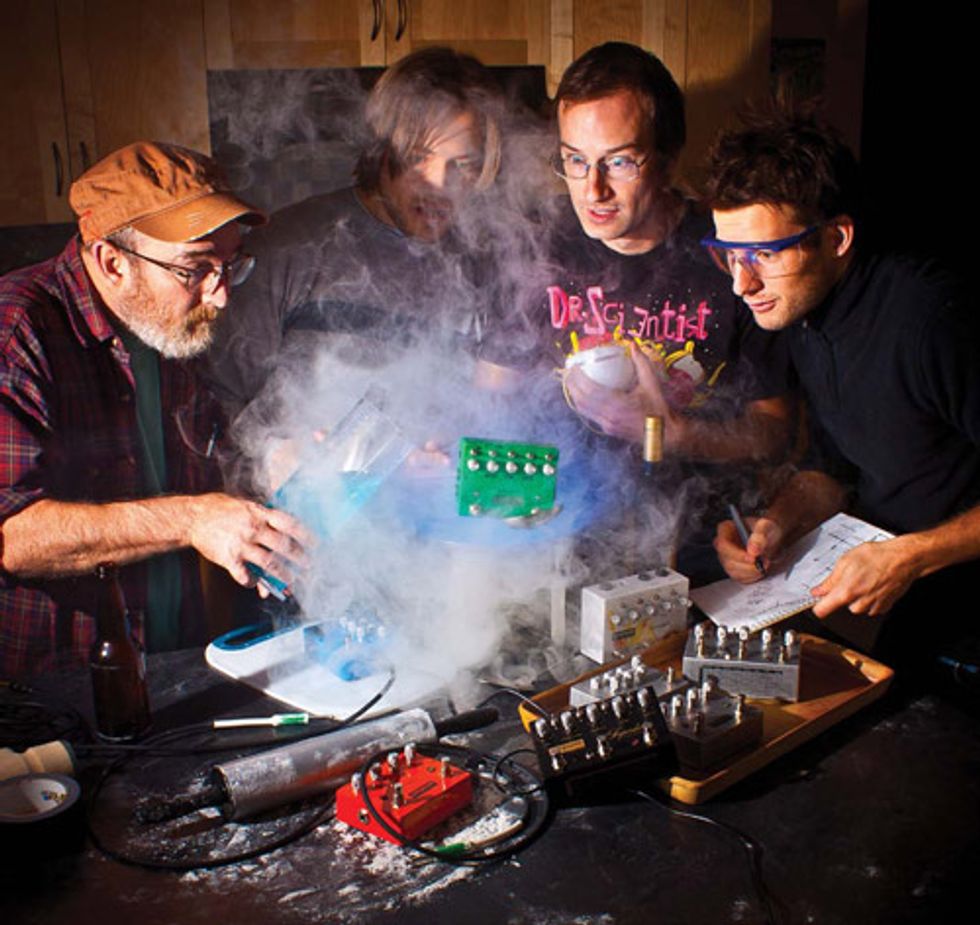
Like scientists amalgamating the best of old and new technologies, the Empress gang—(left to right) Mike Stack, Jason Fee, Steve Bragg, and Dan Junkins—embrace digital processing to extend an effect’s potential in
ways analog circuitry alone cannot.
Unlike some builders, Bragg didn’t fall in
love with any particular pedal in his formative
years. He was more interested in
pedals as a means for learning the way
electronic circuits work, and he gravitated
toward making effects for keyboard players.
He did, however, love the way certain
songs and records sounded. And his first
pedal—a sort of syncopated tremolo that
ultimately found its way into the Empress
Tremolo—was inspired by the song “Vow”
by Garbage.
“I love the idea of combining electronic
and acoustic components, using drum triggers,
having one instrument affect another,
or having effects sync to tempo,” Bragg
says. “There’s a bunch of bands I listened
to growing up—like Archive, Radiohead,
Björk, My Bloody Valentine, and Garbage—
that do that kind of stuff really well. Jonny
Greenwood from Radiohead continues to
be a big inspiration.”
That contemporary frame of reference
may have released Bragg from the baggage
that keeps many analog devotees
unwaveringly in the anti-digital camp. He
readily embraced the possibilities afforded by
having analog circuits and digital processing
working in concert to enhance a guitarist’s
potential. “I really like the idea of having an
analog circuit controlled by a microprocessor.
This makes a bunch of interesting stuff
possible: tap tempo, presets, programmable
triggering, arbitrary waveforms, and completely
new effects that would be impossible
or really difficult with a purely analog design.”
Apparently, many forward-thinking guitarists
agreed with Bragg. “After releasing the
Superdelay, I got a lot of requests to add
mods so it could work with other gear,” he
explains. “Some people wanted to use CV
[control voltage] to control it. Some people
wanted to use relays to control the tempo
instead of the tap stomp switch. Some
wanted MIDI controllability. Unfortunately,
there’s not enough room on a pedal for a
lot of jacks. So we’ve been working for the
past two years on a control port that will
accept a bunch of different inputs: mechanical
switches for remote tapping, expression
and CV inputs, MIDI, and audio input. It’s
been a pain in the ass, but it’s finally all
working. Our first pedal with this control
port will be the Empress Phaser, which we’ll
be releasing sometime soon.”
Bragg and Empress’ open-minded stance
extends to the components that go into their
pedals, as well. They refuse to be constrained
by the emphasis on older components and
instead go with parts that last and sound
best. “We designed our pedals to be as clean
as possible,” Bragg says. “That means using
op-amps, for the most part, and staying away
from transistors that can create headroom,
noise, and impedance issues in the audio path.
I see a lot of funny hype in effects marketing
material, where Teflon wires, expensive capacitors,
gold-plated PCBs [printed circuit boards],
and carbon-composite resistors or 1 percent
resistors are touted as audiophile. I have
serious doubts as to whether these kinds of
things affect the sound in an appreciable way.”
The same emphasis on clarity and quality
makes Empress less concerned with emulating
revered stompboxes, even though they
regard many classic pedals as benchmarks.
“We’ve never been too concerned with
recreating what another pedal can do. But
if we make a pedal with a lot of features,
we want to make sure its basic sound is
as good as the standard go-to pedal. For
instance, when designing the phaser, we set
out to make a pedal that could do stuff no
other phaser could. But if it didn’t sound as
good as an MXR Phase 90, then we’d have
a problem.” Even so, Bragg says, “I think it’s
dangerous to design with someone else in
mind. Instead, I just pretend that I’m a really
creative musician—I know, it’s a stretch!—
and I ask myself what kind of stuff I would
need to make interesting sounds. So far, I
think we’ve only scratched the surface.”



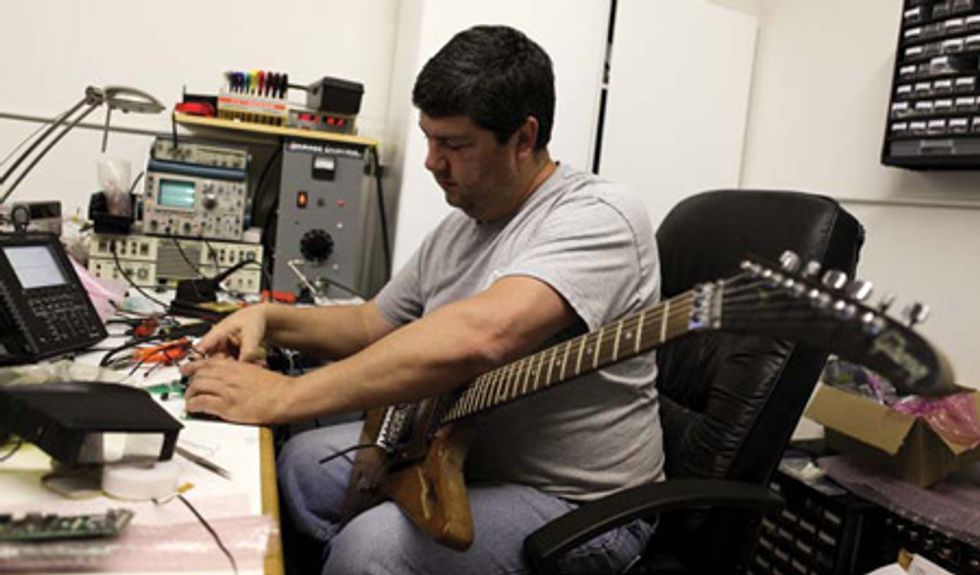
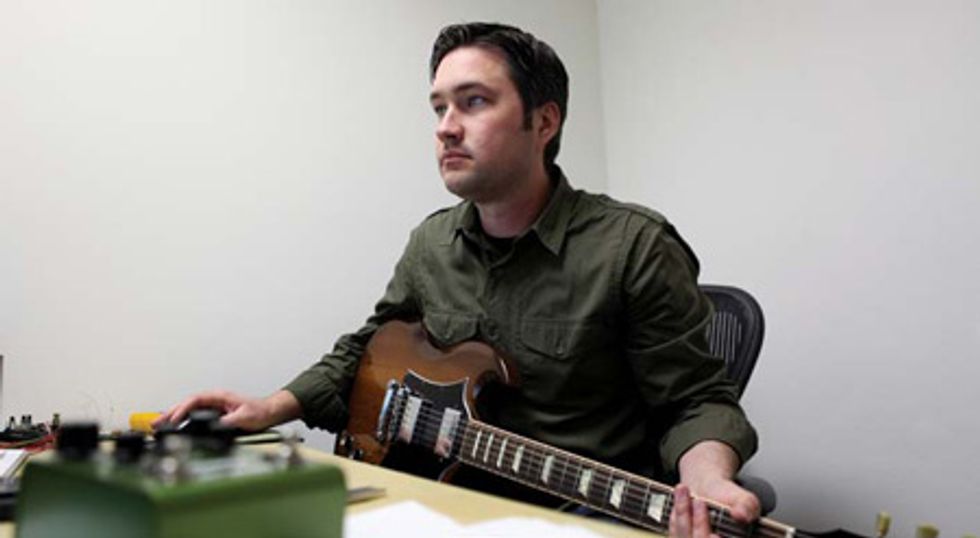




![Rig Rundown: Russian Circles’ Mike Sullivan [2025]](https://www.premierguitar.com/media-library/youtube.jpg?id=62303631&width=1245&height=700&quality=70&coordinates=0%2C0%2C0%2C0)

















